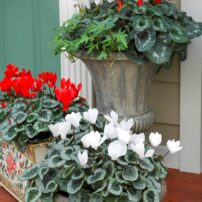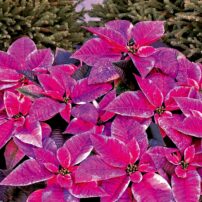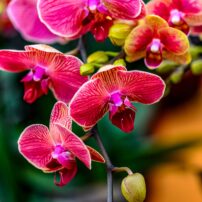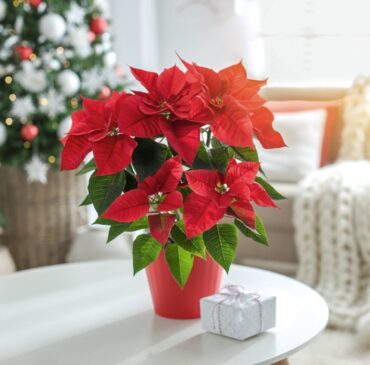
November and December are the perfect months to find three types of indoor plants to brighten up any dull day. These plants are great for all the holidays ahead, from Thanksgiving through perhaps even Valentine’s Day. Read on for some ideas on how to select just the right plant for your own specific wishes.
Poinsettias
You’re hopefully familiar with the abundance of poinsettias available this time of year. They festoon the houseplants sections and other displays at local stores (both small and big box) and are also available at nurseries throughout West Sound. Here’s a little history of these appealing plants and tips for how to care for them.
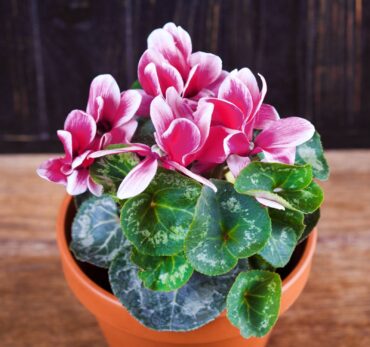
Poinsettias are native outdoor plants in Mexico and Central and South Americas. In these southern climates, poinsettias can grow into small trees — often to 13 feet high. They were named for John Roberts Poinsett, the first U.S. minister to Mexico who is thought to have brought the plants to the USA in the 1820s.
Poinsett sent some of the plants he’d found back to his greenhouses in South Carolina. Some historical records say poinsettias were first exhibited publicly at the Pennsylvania Horticultural Society’s 1829 Philadelphia Flower Show by Col. Robert Carr, who described the plant as “a new euphorbia with bright scarlet bracts or floral leaves, presented to the Bartram Collection by Mr. Poinsett, United States minister of Mexico.”
Poinsettias are indeed euphorbias. When a stem is broken, white sap leaks out, just like our outdoor euphorbias. This white sap can sometimes cause a skin reaction, so be careful, just as you would be with outdoor-growing euphorbias.
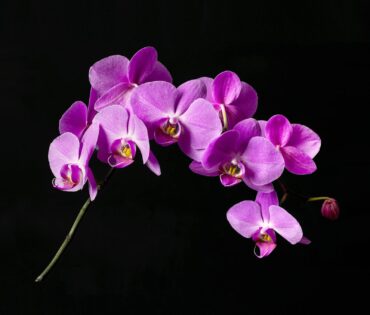
Years ago, several West Sound high school horticulture classes grew poinsettias to sell during the holidays and help fund their programs. This was not an easy task. Poinsettias require at least 14 hours of darkness for six to eight consecutive weeks to produce the colorful blooms. These blooms are actually the leaves of the plant. If the darkness is interrupted, the leaves will not change color.
The true flowers are those tiny, yellow and green small balls clustered in the middle of the colorful leaves. The colorful leaves and their true flower clusters are commonly called the blooms of poinsettias. Now poinsettias are found in white, red, yellow, pink and several dappled colors. You’ll also find turquoise blue and even glitter-speckled blooms (these are not grown that way).
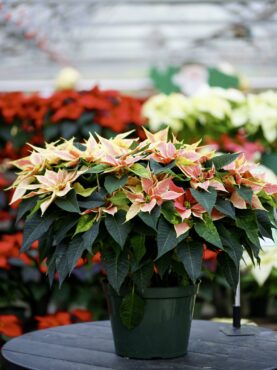
Poinsettias are happiest in well lit areas of the home. Just like most of your daylight-loving favorite houseplants. Poinsettias are often sold in containers wrapped in a waterproof covering. Give yourself permission to discard this wrapper and place them in a colorful container used for houseplants. Even a basket works well.
Water the poinsettia in the sink, let it drain and then place back in its decorative container. Poinsettias fare best when watered at least once a week. No need to fertilize these beauties. If leaves start drooping, water more frequently, but make sure the water drains out each time.
Cyclamen
Cyclamen is another popular holiday and winter houseplant for long-lasting blooms through the darker months of the year. Nowadays, it’s available almost all year long.
There are actually 23 species in the genus Cyclamen. The cyclamen discussed here is Cyclamen persicum. The University of Wisconsin Extension has a great publication with enticing photos all about cyclamen as a houseplant. See the link in the sidebar for even more information.
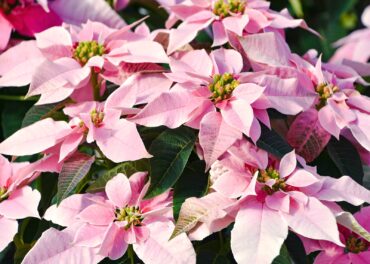
Cyclamen persicum grows from a fat, round, flattened tuber. The tuber is brown, and it’s where the twisty leaf and flower stems emerge from. When you see them in stores, they’re usually in full, colorful bloom. Purchase a plant that still has lots of buds that have not yet opened.
Leaves come in shades of dark green, mottled green, silvery-streaked green and even with purple undersides. Blooms can be found in white, red, pink, lavender and magenta.
These appealing plants also might come with a foil or cellophane wrapper. With cyclamens, you’ll want to remove the plant in its plastic container from the wrapper and water it in the kitchen sink, allowing the water to drain out thoroughly before returning the plant to its wrapper. Or, just like with poinsettias, you could put the plant in its container into a decorative pot or basket. Bottom line, ensure the container you select has good drainage. Water around the edges of the plant rather than directly on top of the round tuber.
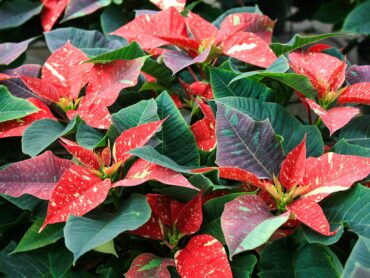
In the wild, cyclamen grow in very dry areas with lots of sun. If you were ever to visit Greece, North Africa or anywhere near the Mediterranean, you’d see these blooming plants festooning the rocky hillsides and canyons.
All cyclamen (even as houseplants) go through a dormant period each year. Purchased cyclamen will begin going dormant after three months, often in spring, with leaves and flowers starting to fade. Reduce watering at this time.
Once your purchased cyclamen is through blooming and all the blooms and leaves have stopped emerging and thriving, remove the tuber from the soil and let it dry out completely. At this point, you could consider it an annual and compost the tuber. But you could also store it in vermiculite and let the tuber rest for two to three months. Then plant it back into potting soil and start watering again and voila! — perhaps you’ll have a blooming cyclamen all over again.
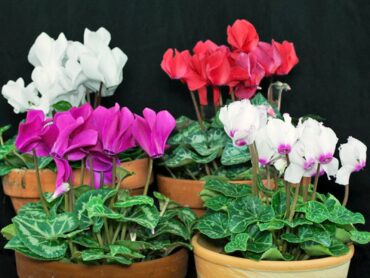
In early spring, holiday cyclamen can also be planted outside in containers and have been known to rebloom in several weeks. They often don’t make it through winter outside though.
Orchids
Orchids are another holiday plant in abundance during late fall and winter months especially. Houseplant sections of local nurseries, stores and at the entrance to Trader Joe’s are often filled with enticing orchids. Read the accompanying plant tags and select phalaenopsis, oncidium or dendrobium, which are perhaps the most user-friendly to grow, enjoy and keep alive.
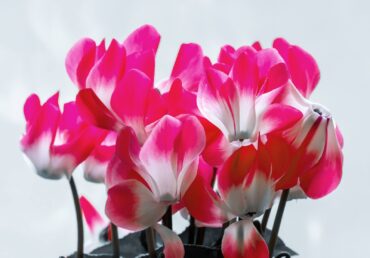
Phalaenopsis: Rated as easy to grow and reblooms several times a year. This orchid is often called moth orchid because the blooms march up the stem and some people feel they look like moths. The blooms last for many weeks and eventually dry up and fall off, one at a time. However, the stem will often make more blooms, or another stem will grow out of the original stem.
Wait several weeks before removing the bare stem from the plant. The foliage is often an elongated, oval, thick, dark green shape. Usually grows in pairs of leaves emerging or clustered together. Air roots are thick and usually green. The planting medium is mostly bark.
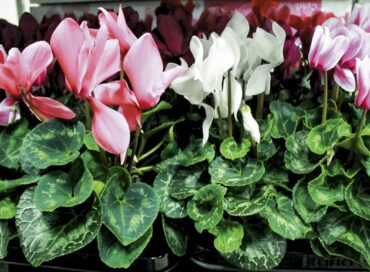 Oncidium: Produces numerous small flowers on long, slender stems. The foliage consists of a flattened, oval, fleshy, thick stem with a single leaf emerging. The foliage emerges in clusters, with flower stems emerging from the clusters.
Oncidium: Produces numerous small flowers on long, slender stems. The foliage consists of a flattened, oval, fleshy, thick stem with a single leaf emerging. The foliage emerges in clusters, with flower stems emerging from the clusters.
If the plant doesn’t receive enough water, the leaves will look wrinkled or pleated. This shows that the plant needs more frequent watering. The leaves will usually return to their normal appearance. The planting medium is usually a combination of bark and moss.
Dendrobium: Also reblooms and has clusters of brightly colored flowers. The green stems of dendrobium are single canes, with single and double sets of leaves marching up the stem. Bloom stems emerge from the canes.
As the plant ages, new orchid stem clusters (i.e., miniatures of the parent plant) emerge with white air roots attached to them. These can be replanted and will eventually (very eventually) grow into the same size as the parent plant. Planting medium is bark.
In the wild, orchids usually grow among the branches and bark of trees. They can also be found nestled in with lichens and mosses. Usually, they’re found in tropical areas of the world.
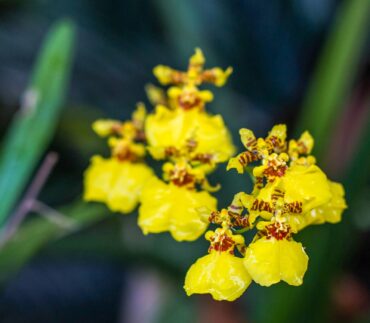
Even though they’re found in among trees, orchids (as houseplants) need bright but indirect light to live happily. They’ll enjoy being placed in an east- or west-facing window but not in direct hot sunlight.
All three of the orchids listed require regular watering and fertilizing. Local nurseries and home and garden stores sell orchid potting mixes and fertilizers. Also available are orchid containers with holes for air circulation so the orchid doesn’t rot from too much dampness.
Water orchids once a week and fertilize regularly. Watering in the sink and allowing the container to drain is a good idea. However, some orchid growers recommend placing clusters of containerized orchids on a pebble-lined, water-filled tray so that the container receives humidity from the water in the tray but the orchid itself is not sitting in water.
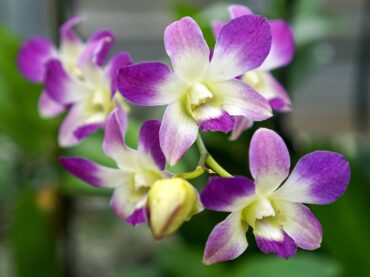
Another tip is to give orchids a “shower” once a week or at least once a month. This can be accomplished by misting the orchids or placing the containerized plant in the shower and running tepid water for a short time. This also works well to wash dust off the foliage. After watering, always let the containerized orchids drain well before returning them to their daylight-drenched locations in your home.
Purchasing and Other Tips
When selecting plants at the store or nursery to purchase and bring into your home, tap the plant on the table where it’s displayed. This tapping will dislodge or disturb moisture gnats or other flying or hopping insects. If you see an insect, leave the plant there and search for another one without any hitchhikers.
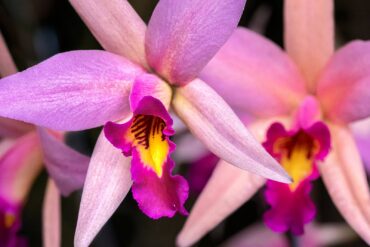
Phalaenopsis often comes in a clear plastic container inside of a solid container. Growers of orchids have found that this particular orchid is happy in this condition. Make sure the clear plastic container has drainage at the bottom and when watering, remove it from the solid container until the water drains out.
Check out the links listed in this piece for more photos and additional information if you get hooked on a particular plant. Various plant societies and websites ending in .edu are your best choices for information. When you see .edu, it usually means it’s an extension university website, which has science-based and well-researched information. The plant society websites also have great information from the experts and growers of those particular plants.
Enjoy the holidays ahead — and perhaps you’ll want to enjoy and give a home to one or more of the plants suggested for indoor delight.




